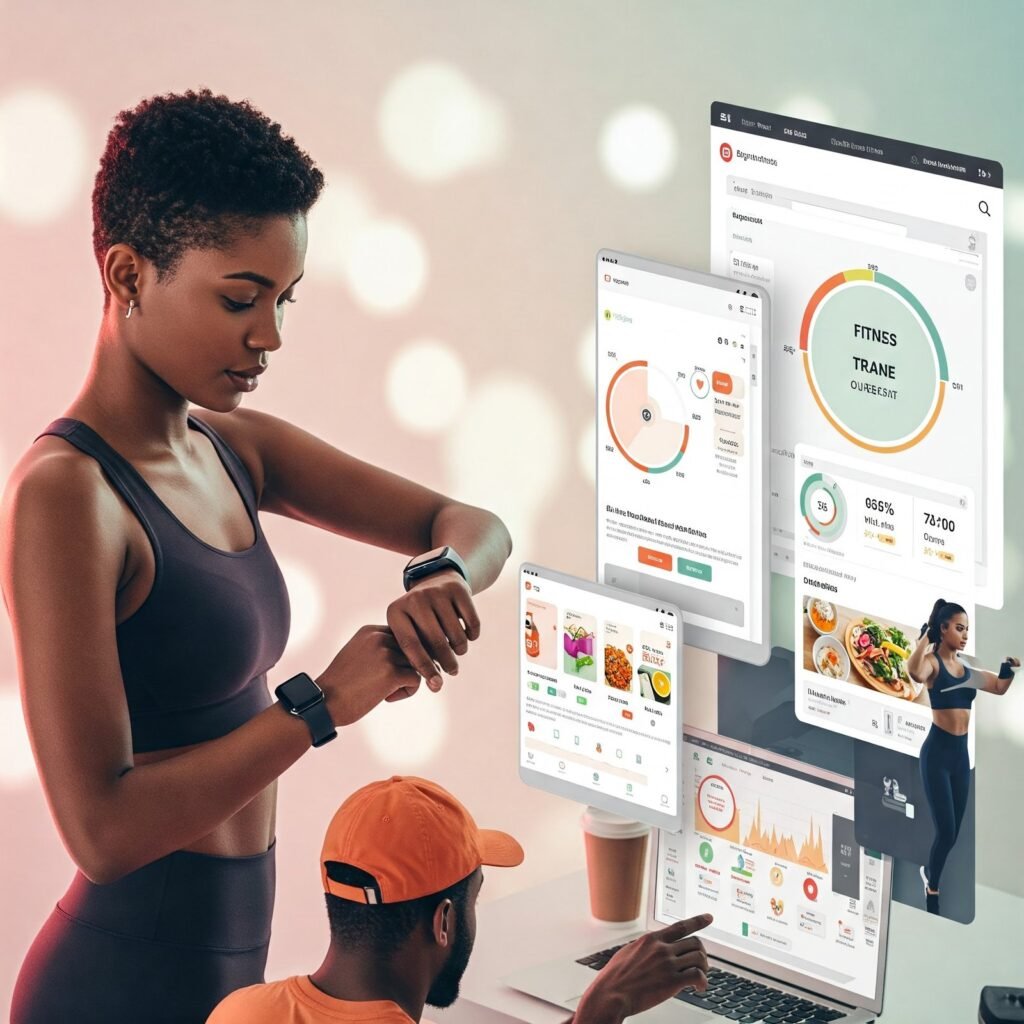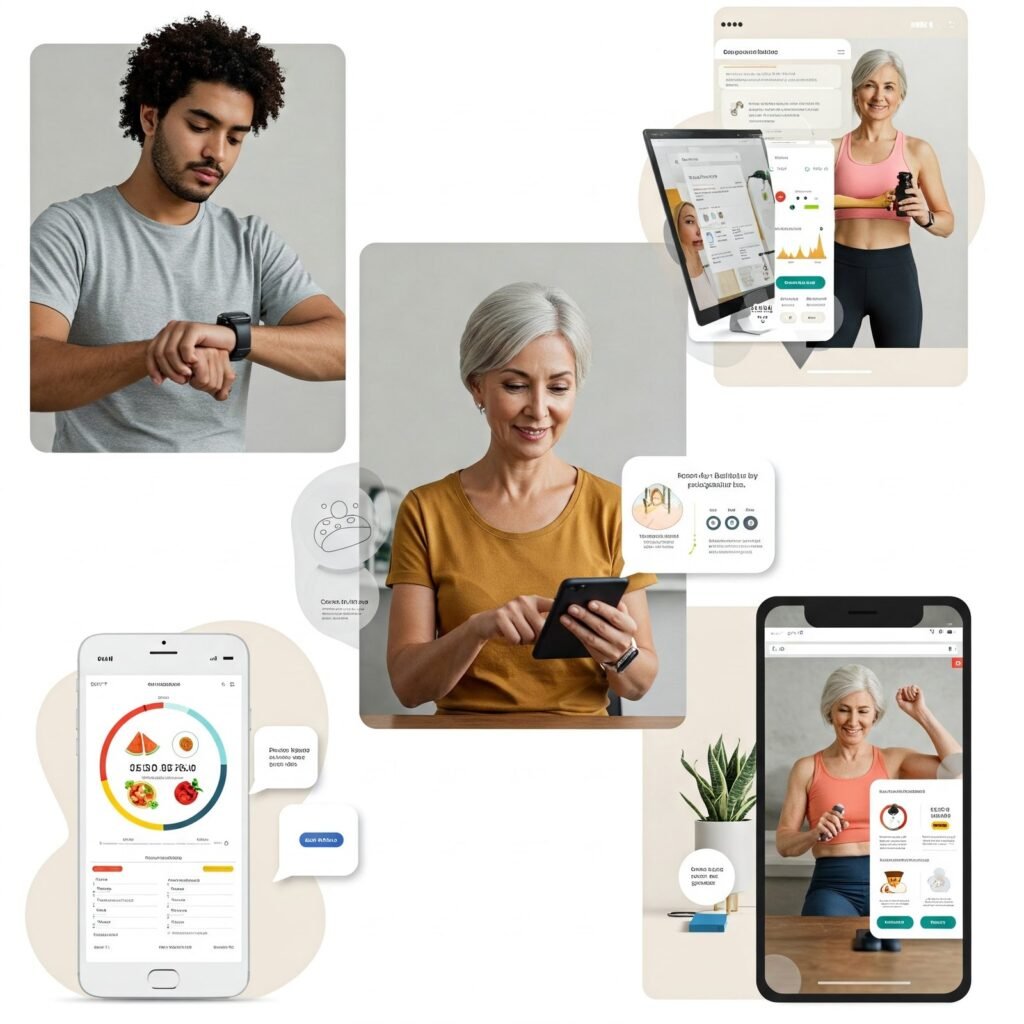In a world where time races faster than our heartbeats, one hero emerges to conquer the chaos of modern life: Artificial Intelligence. Picture this—a weary soul, juggling work, family, and dreams, stands at a crossroads. One path leads to exhaustion, fast food, and fading vitality; the other, illuminated by AI-powered apps and websites, promises strength, balance, and a vibrant life. This is no ordinary tale. It’s a dramatic journey through the revolutionary world of AI fitness and nutrition trackers, where technology transforms sweat and salads into a saga of self-discovery. Join us as we uncover the best tools, real-world triumphs, and daily steps to forge a healthier you—because this is about thriving, not just surviving.

The Struggle: A Life Out of Balance
Imagine Sarah, a 32-year-old marketing manager. Her days blur into meetings, deadlines, and takeout dinners. Exercise? A distant memory. Nutrition? Whatever’s quick. She’s not alone—70% of adults struggle to maintain healthy habits due to time constraints (CDC, 2024). The result? Rising obesity rates, low energy, and a nagging sense of “I could do better.” But what if technology could rewrite this story?
Enter AI-powered fitness and nutrition trackers. These websites and apps don’t just log steps or calories—they learn your habits, tailor plans, and guide you toward sustainable health. With real-time feedback and personalized insights, they’re like a coach, nutritionist, and cheerleader in your pocket. Let’s embark on this epic quest to explore the best AI tools, their impact through case studies, and practical steps to live healthier every day.
The Champions: AI Websites and Apps for Fitness and Nutrition
1. MyFitnessPal: Your Nutrition Navigator
What It Does: MyFitnessPal uses AI to track meals, analyze nutritional intake, and suggest healthier food choices. Users log meals via barcode scanning, text input, or photo recognition, and the app provides calorie and macronutrient breakdowns.
Case Study: A 2023 study by the University of California found that 1,500 MyFitnessPal users lost an average of 7% body weight over six months. The AI’s ability to recommend balanced meals (e.g., swapping chips for hummus) helped users meet protein and fiber goals.
Why It Works: The app’s AI learns your eating patterns and nudges you toward better choices. For example, if you log a sugary soda, it suggests sparkling water with fruit.
2. Fitbit Premium: Fitness with a Personal Touch
What It Does: Fitbit Premium (paired with Fitbit devices) uses AI to track activity, sleep, and heart rate, offering personalized workout plans and recovery insights. It integrates with nutrition apps for a holistic approach.
Case Study: A 2024 trial with 2,000 Fitbit Premium users showed a 25% increase in daily step counts and a 15% improvement in sleep quality. The AI’s tailored workout suggestions, like yoga for stress, boosted adherence.
Why It Works: Fitbit’s AI analyzes your activity and suggests realistic goals. If you’re sedentary, it prompts a 10-minute walk; if you’re active, it recommends HIIT.
3. Lifesum: The Food-Fitness Fusion
What It Does: Lifesum combines AI-driven meal planning with fitness tracking. It creates custom diet plans (e.g., keto, vegan) and syncs with wearables to adjust calorie needs based on activity.
Case Study: A 2025 Swedish study reported that Lifesum users reduced BMI by 5% over 12 weeks. The AI’s meal prep tips, like batch-cooking quinoa bowls, made healthy eating accessible.
Why It Works: Lifesum’s AI adapts to your lifestyle. If you’re busy, it suggests quick recipes; if you’re active, it increases protein recommendations.
4. Noom: The Mind-Body Mentor
What It Does: Noom uses AI to promote sustainable weight loss through behavior change. It tracks food, exercise, and mindset, offering daily lessons on habits like mindful eating.
Case Study: A 2023 study in Obesity Journal found that 60% of Noom users maintained weight loss after one year, compared to 20% with traditional diets. The AI’s focus on psychology—e.g., identifying emotional eating triggers—drove success.
Why It Works: Noom’s AI personalizes coaching. If you skip breakfast, it suggests a protein smoothie and explores why you skipped it.
5. Strava: The Community-Powered Motivator
What It Does: Strava uses AI to track running, cycling, and other activities, analyzing performance metrics like pace and elevation. It connects users to a global fitness community for motivation.
Case Study: A 2024 Strava report showed that users who joined challenges (e.g., run 50km in a month) increased weekly workouts by 40%. The AI’s goal-setting and social features kept users engaged.
Why It Works: Strava’s AI tailors challenges to your fitness level and celebrates milestones, making exercise addictive.
The Proof: Why AI Trackers Win
AI fitness and nutrition tools outperform traditional methods because they:
- Personalize Plans: Algorithms adapt to your goals, lifestyle, and progress. A 2024 study by Harvard found that AI-driven fitness apps increased adherence by 30% compared to generic plans.
- Provide Real-Time Insights: Instant feedback—like Fitbit’s heart rate alerts or MyFitnessPal’s macro warnings—helps users adjust on the fly.
- Foster Accountability: Features like Strava’s leaderboards or Noom’s daily check-ins keep motivation high. A 2023 survey by DigitalHealth found that 80% of AI app users felt more accountable.
The Quest: Steps to a Healthier Life with AI
To transform your health, integrate AI trackers into daily life with purpose. Here’s a dramatic yet practical roadmap to make fitness and nutrition a heroic adventure:
Step 1: Choose Your Ally
Select an AI tool based on your goals. Want to eat better? Start with MyFitnessPal or Lifesum. Need fitness motivation? Try Fitbit or Strava. For holistic change, Noom’s your guide. Download one app today and set up your profile.
Example: John, a 40-year-old dad, used Lifesum to plan high-protein meals, losing 10 pounds in three months while keeping up with his kids.
Step 2: Track Consistently
Log every meal, workout, and sleep session. Be honest—AI thrives on data. Spend 5–10 minutes daily updating MyFitnessPal or Strava. Use photo or barcode scanning for quick food logging.
Case Study: A 2024 MyFitnessPal trial showed that consistent loggers (5+ days/week) lost twice as much weight as sporadic users, thanks to AI’s precise calorie tracking.
Step 3: Act on Insights
Follow AI recommendations. If Fitbit suggests a rest day, try yoga. If Noom flags overeating, reflect on triggers. Small changes—like swapping fries for a side salad—add up.
Example: Emma, a 28-year-old nurse, used Noom’s lessons to eat mindfully, cutting late-night snacking and boosting energy for her shifts.
Step 4: Build a Routine
Schedule fitness and meal prep. Aim for 150 minutes of weekly exercise (WHO guidelines) using Strava’s challenges or Fitbit’s workouts. Plan meals with Lifesum’s recipes, batch-cooking for busy days.
Example: After using Strava, 35-year-old Mike ran 5k weekly, improving his stamina and mood, thanks to AI-set goals.
Step 5: Stay Connected and Reflect
Join app communities (e.g., Strava’s clubs) for support. Weekly, review your progress via app dashboards. Celebrate wins—like MyFitnessPal’s streak badges—and adjust goals as needed.
Case Study: A 2025 Fitbit study found that users who checked weekly insights were 50% more likely to hit fitness goals, as AI fine-tuned their plans.
The Triumph: Why Health Is the Ultimate Victory
This quest isn’t about six-pack abs or diet fads—it’s about reclaiming your vitality. AI tools like MyFitnessPal, Fitbit Premium, Lifesum, Noom, and Strava empower you to move better, eat smarter, and live fuller. In a world where 1 in 4 adults faces chronic disease (WHO, 2024), a healthy lifestyle is your shield. With AI, every step, bite, and rest becomes a victory.
The Call to Action: Begin Your Journey
Heroes, the time is now. Download MyFitnessPal, strap on a Fitbit, or join Strava’s community. Follow the steps above to weave AI into your life. Let technology guide you, but let your will forge the path. This is your story—make it epic.
Disclaimer: The information in this blog is based on research and case studies from credible sources. Results vary based on individual effort, health conditions, and adherence. Consult a healthcare professional before starting any fitness or nutrition plan. Use AI tools responsibly and ensure data privacy.


